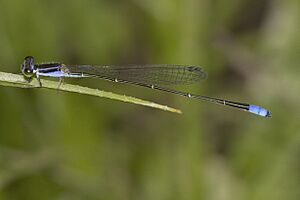Aciagrion approximans facts for kids
Quick facts for kids Aciagrion approximans |
|
|---|---|
 |
|
| A. a. approximans | |
 |
|
| A. a. krishna | |
| Conservation status | |
| Scientific classification | |
| Synonyms | |
|
The Aciagrion approximans, also known as the Indian violet dartlet, is a type of damselfly. Damselflies are delicate insects, similar to dragonflies, but they usually hold their wings together over their body when resting. This species belongs to the Coenagrionidae family.
You can find the Indian violet dartlet in parts of India, especially in the eastern and southern regions. Its home also stretches to countries like Thailand, China, and Cambodia.
Different Types
Scientists sometimes find slight differences in animals that live in different places. These slightly different groups are called subspecies. For the Indian violet dartlet, there are two main subspecies:
- Aciagrion approximans approximans: This type is mainly found in Northeast India.
- Aciagrion approximans krishna: This type lives in the Western Ghats region of southern India.
Early studies by Frederic Charles Fraser thought these two might be different species. However, newer research shows they are very closely related. They are just different forms of the same species.
What It Looks Like and Where It Lives
The Indian violet dartlet is a small and very thin damselfly. It often has beautiful violet and black colors.
Its main body part, called the thorax, is black. It has cool violet stripes along its sides. The long, thin abdomen, which is the tail-like part, also has a mix of colors. Segments 2 to 7 of the abdomen are black on top and violet underneath. Segments 8 and 9 are mostly violet with no other marks. The very last segment, number 10, is black on top.
In the A. a. krishna subspecies, the lower part of segment 8 has a black mark. Female damselflies look similar to the males. However, their colors are usually a bit paler. Also, segments 8 and 9 of the female's abdomen are black, and segment 10 is blue on top.
These damselflies like to live near water. They often breed in calm places like ponds and lakes. You might also spot them near slow-moving streams.
See also
- List of odonates of India
- List of odonata of Kerala


